While Uttarakhand, especially Garhwal region, is known for its holy destinations, such as river-side temples, river origin temples and Kshetras dedicated to Lord Shiva (hence referred to as Dev Bhoomi or Shivalik), there is one town which exhibits lot of British character. That’s because it indeed was built and inhabited by the British. In fact, an author of famous childrens’ books, who was born in India but is of British descent, Ruskin Bond, lives at this charming hill station. We are talking about Mussoorie in Dehradun district.
Geography of Mussoorie
Mussoorie is in the lower reaches of Garhwal mountains, 35 kilometres uphill on the highway from Dehradun to Uttarkashi. Mussoorie is at an average altitude of 2000 metres (6,600 feet) above sea level. The highest point, Lal Tibba, is at an elevation of 2275 metres (7465 feet). To the south of Mussoorie is the flat valley of Dehradun, which also can be spelt as Dehra Doon. A Doon in Garhwali language means a valley. Dehradun is so called because of the forests of Dehra trees that used to grow there, but have now been cleared to give way to the city. To the north of Mussoorie are higher Garhwal mountains, where two of the most famous Indian rivers, Yamuna and Bhagirathi, originate. Also to the north of Mussoorie are some of the most famous treks in Garhwal, e.g. Kedarkantha, Rupin Pass and Har Ki Doon.
People of Mussoorie
People native to Mussoorie are Garhwalis, of the people of Garhwal region. Garhwal is the region of Uttarakhand where the Ganga river and its tributaries flow. The people speak a language that sounds like Hindi, but borrows heavily from Rajasthani languages such as Rajasthani and Marwari.
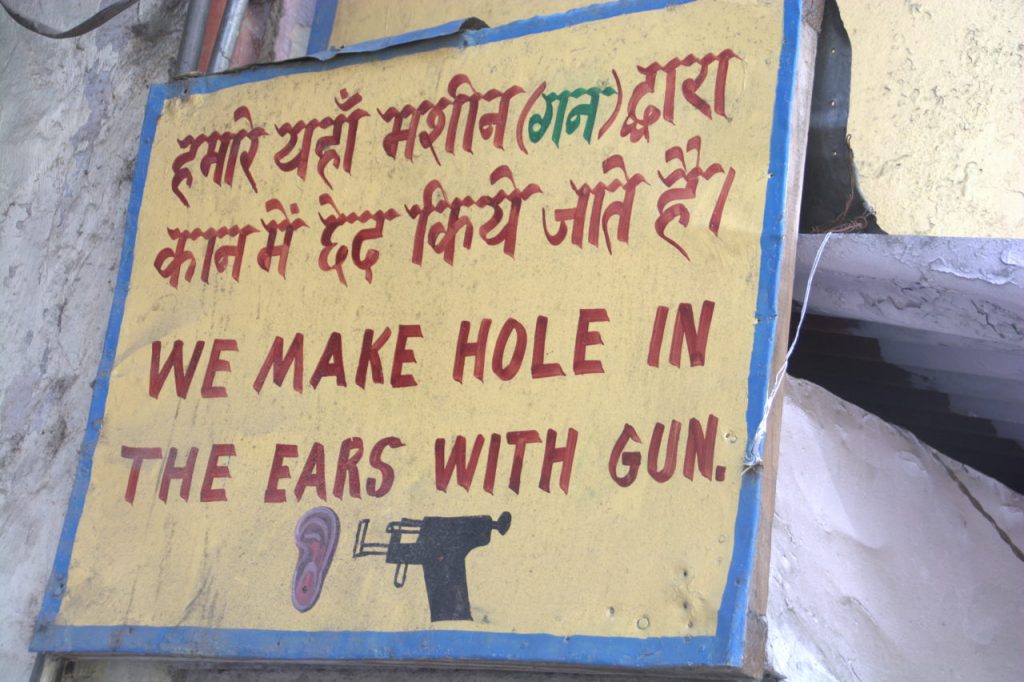
The people of Mussoorie mostly work in tourism-related occupations. Plenty of them own hotels or homestays or work as part of them. Running shops and eateries for tourists is also a major occupation among the locals of Mussoorie. Local transport is operated by taxi drivers and cycle rickshaws. But the most interesting occupation around Mussoorie is in a small village north-east of Mussoorie. This village is a Dhobi Ghat or a place where clothes are washed. Truckloads of laundry is sent from the hotels and resorts of Mussoorie to this village for washing and drying. It is common for every home in this village to have two or more washing machines.
Here are the most interesting places to see in Mussoorie
Mall Road
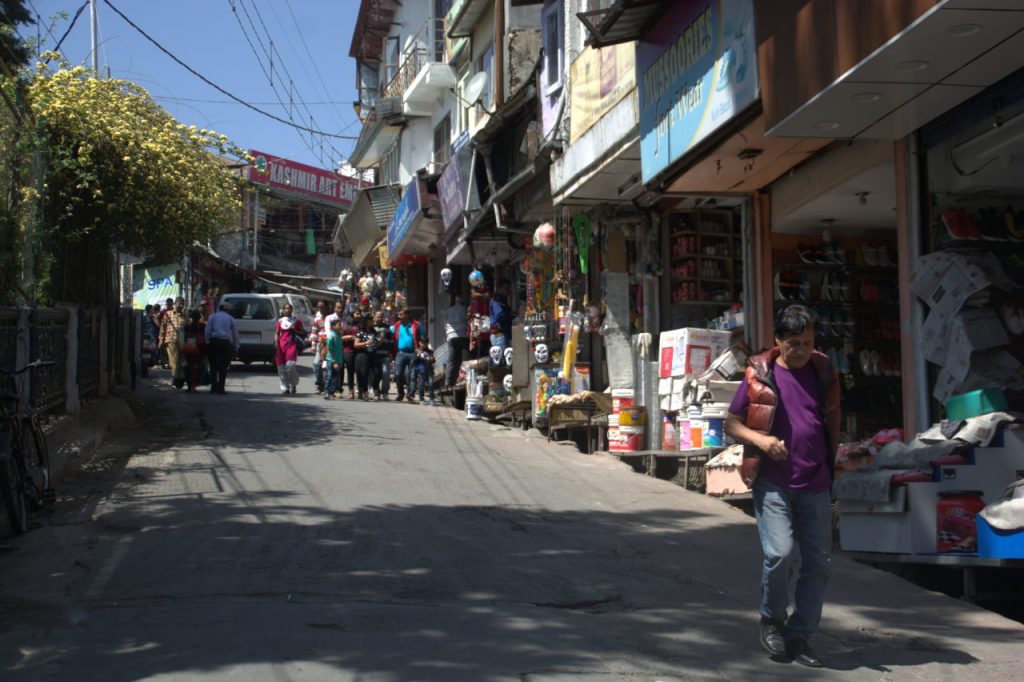
The busy Mall Road in downtown Mussoorie.
The Mall Road is the main road of Mussoorie town. It stretches about 2.2 kilometres with Kulri as its lowest point to the south of town and Library Chowk (now Gandhi Chowk) as the north-most end and the most elevated point of the roed. On this road are Mussoorie’s most popular hotels, shops, boutiques and resorts. There are also some heritage hotels continuing to operate from the time of British Raj. Halfway down the Mall Road is a cable car that takes you to the top of Gun Hill, the highest point within the limits of Mussoorie municipality. This is also one of the two points where you can hire bicycle rickshaws to ply around Mussoorie, the other point being the Library Chowk.
At the Kulri end of Mall Road was India’s first multiplex named Picture Palace. Today, the movies no longer exist, but Picture Palace complex still operates as a game arcade with 3D game consoles, 7D experience kiosks and indoor mini sports.
During certain hours of the day, Mall Road is closed to motor vehicles and fully pedestrian. Use those hours to explore Mall Road on foot without the fear of getting run over by some rash driving (yes, plenty of Garhwalis are rash drivers!). However, if it is a weekend, you will still keep bumping and jostling for space with hordes of people from Dehradun, Delhi and NCR, who use Mussoorie as a weekend getaway.
Camelback Road

Camelback is the less used road to commute from Kulri to Library Chowk
While the Mall Road is a road that runs between Kulri and Library Chowk while sticking to the middle of town, Camelback road is a road that runs between the same two points of the city, but runs along the edge of the mountain that contains Mussoorie. It can be used for a relaxed morning or evening walk promenade, away from the crowds of Mall Road. From Camelback road, one can see layers of Garhwal mountains as they grow from foothills to the full heights of the Greater HImalayas.
From Camelback Road, it is also possible to go to Gun Hill by foot. A foot trail starts from the road and winds through the back of Club Mahindra Resort’s colourful cottages. It ascends sharply to reach the top of Gun Hill.
Gun Hill

Club Mahindra resort’s multi-coloured resort buildings near Gun Hill.
Gun Hill is the highest point of Mussoorie municipality area, though not the highest point of what we cover in Mussoorie tourism. The point appears as a hill that appears higher than the rest of the city. The hill is flanked by Mall Road on one side and Camelback road on the other. One can get there either by cable car of by foot.
At the top of the hill, there is a food court with several stalls sellling chaat items, Pizza, Paratha, etc. There are games like dart throwing, etc. Gun Hill is not really a place for activities. These activities are part of any city in India. The most striking feature of the hill is the vantage point and the complete view of Mussoorie and the Dehradun valley. Evenings at Gun Hill is annoying due to the crowds. You can visit Gun Hill during a morning walk along Camelback road. The cable car does not start before 10 am, nor the various shops at the top of Gun Hill, allowing for landscape photography with few people to block your view. That also means that food is not available and that you should get something to eat before you start.
Library Chowk

The iconic Mussoorie Library, now dysfunctional.
Library Chowk is so named because of the Town Library that used to operate at this busy junction. Today the library is no longer functional and the junction is called Gandhi Chowk, due to the statue of Mahatma Gandhi at a viewing gallery to the side of the junction.
Library Chowk is the primary town square of Mussoorie, with the Kulri junction being a supplementary one. 5 roads meet at this junction and there are some seriously expensive hotels and resorts here, in addition to branded showrooms. To the side of the junction is a viewing gallery that overlooks the Himalayas. This is the view gallery where a statue of Mahatma Gandhi stands. The viewing gallery at Library Chowk is the most ‘selfied’ point in Mussoorie. Most tourists stay in hotels clustered around this Chowk and hence it draws plenty of crowd. This is also the point where state buses plying between the valley (Dehradun, Haridwar, Rishikesh) and Uttarkashi halt to take in passengers from Mussoorie. Taxis also use Library Chowk as the pickup point to ferry tourists.
Landour
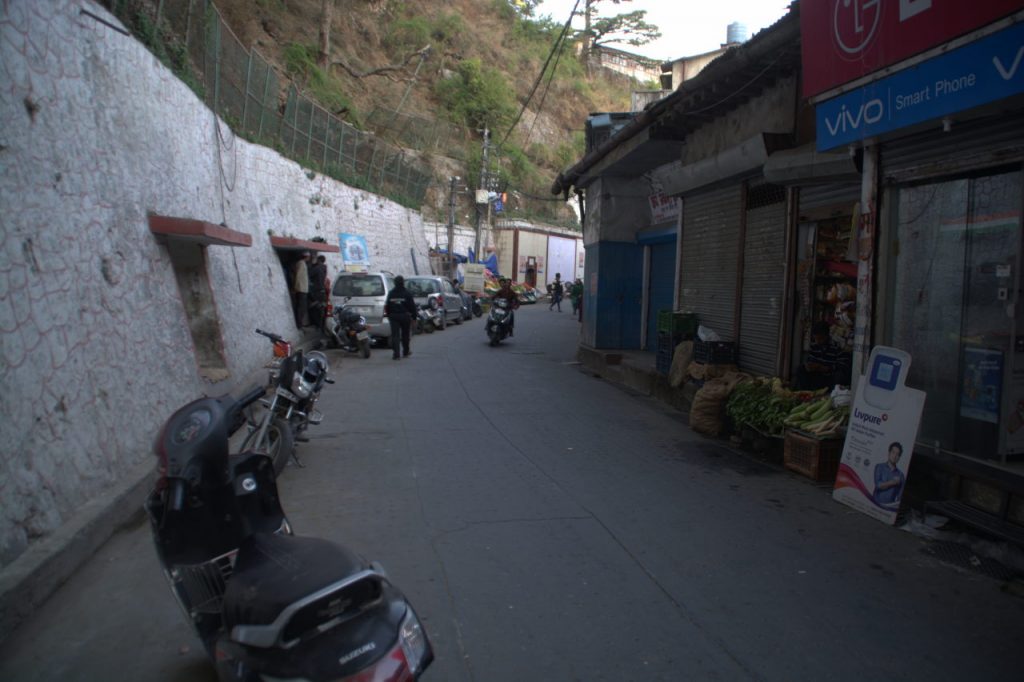
Landour market.
Landour is a cantonment adjoining Mussoorie. For tourism purposes, it is considered part of Mussoorie city since there is no visible boundary between the two towns. Landour can be reached from Kulri chowk. While Mall Road is bustling with tourists, Landour is mostly residential and full of Garhwali locals. It is also a place where you can find foreign tourists staying in hostels, avoiding the crowds of Indian tourists. You will see various cafes throughout Landour, exclusively serving items preferred by the Western world. Mall Road’s Parathas, chaat and masala chai make way for bread, pastries and English tea. It is also in Landour that you will see several boarding schools started during the British rule. They still draw students from all over India and also from neighbouring countries like Nepal.
Lal Tibba
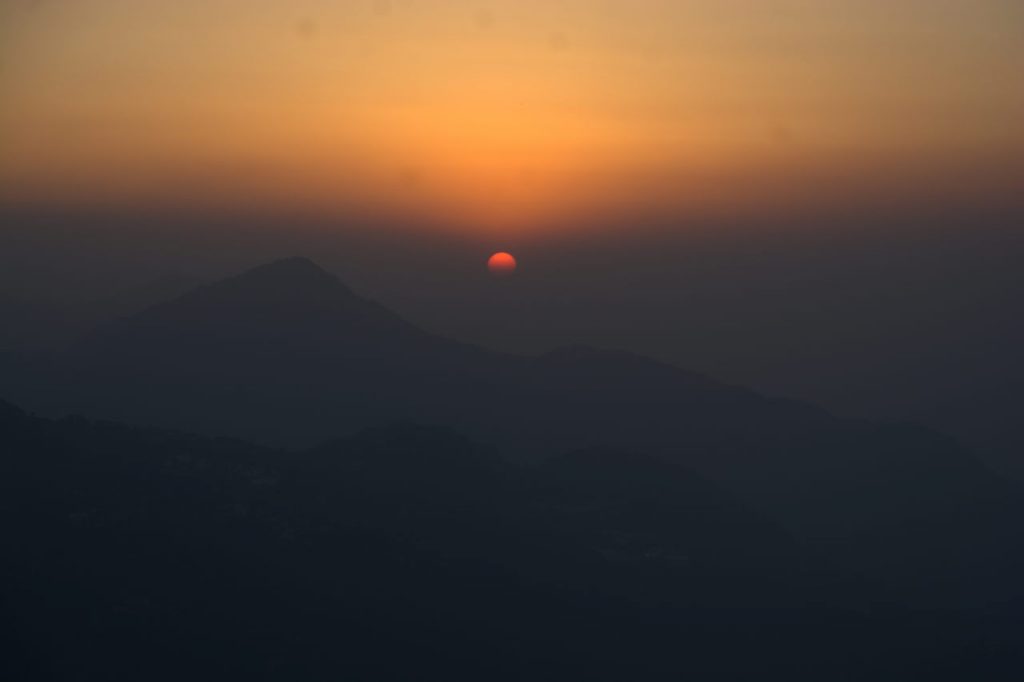
The vista of the sun setting over Mussoorie as seen from Lal Tibba.
Lal Tibba is the highest point within what is the tourism-covered Mussoorie. The point is nowhere close to Mussoorie town and is in fact quite a walk away from Landour too. But while you can muscle your way with a long evening walk, it is also possible to reach Lal Tibba by a vehicle, because there is a good road all the way to the view point at the top of the hill.
At Lal Tibba, one can get a beautiful view of the sunset and sunrise. The view point is a small restaurant with a viewing deck on the first floor. To access the first floor, you need to purchase a ticket at the restaurant counter.
Dhobi Ghat and Pari Tibba
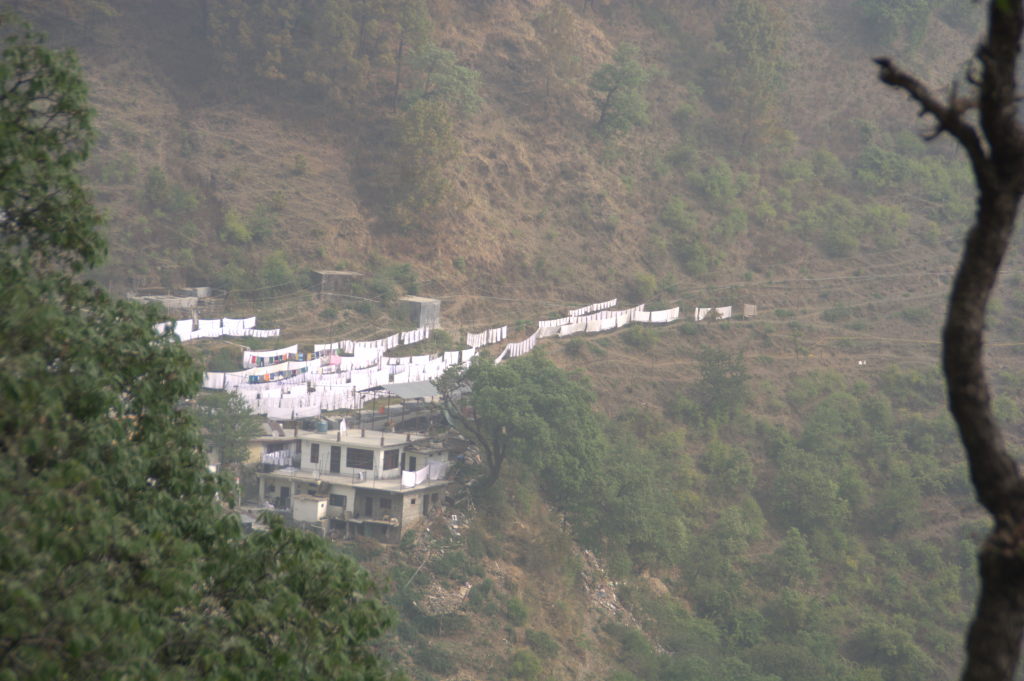
Laundry from Dhobi Ghat village can be seen even from high up in the trail to Pari Tibba.
As mentioned in the paragraph on the people of Mussoorie, Dhobi Ghat is a village outside Mussoorie town that consists of families that do the laundry for all the hotel in Mussoorie that offer laundry service. Truckloads of clothes are sent to the village for cleaning and drying.
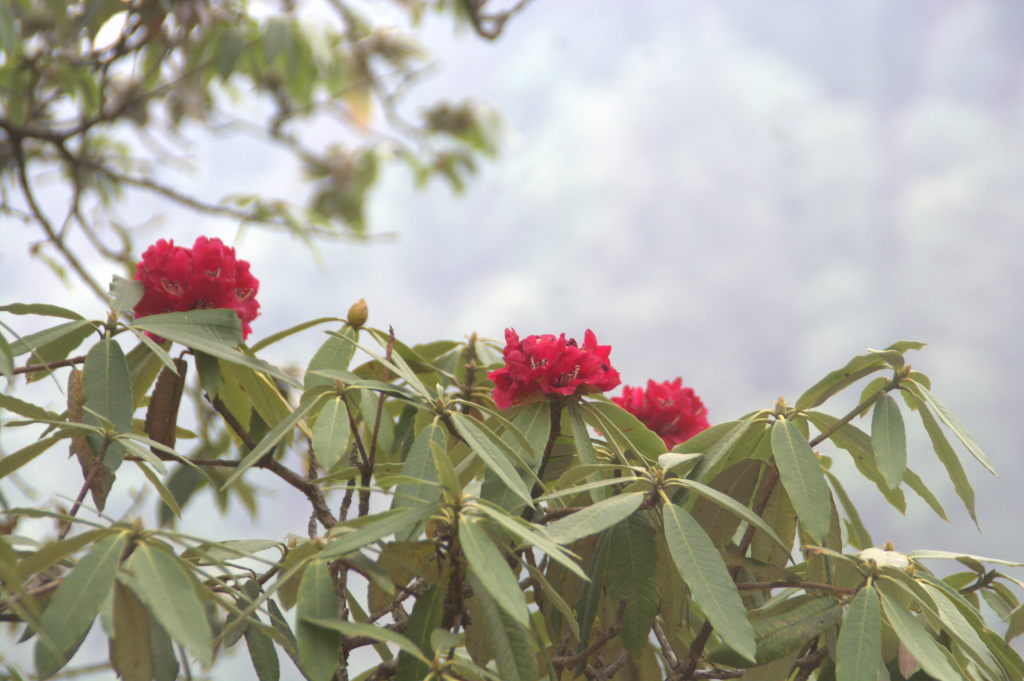
Rhododendrons in full bloom at Pari Tibba
Walking further from Dhobi Ghat, one can reach Pari Tibba, a hill top that is supposedly cursed. This is believed because of the frequent lightning strikes that happen on the hill top, several of which have decimated trees and even burned down the side of houses. As a result, Pari Tibba is an unhabited place, with the remnants of buildings found on the way.
Company Garden
About 5 km from Mussoorie is a botanical garden named Company Garden. It is quite far from the town, so it makes more sense to take a bicycle rickshaw or a taxi to this location. We walked the entire distance on the way from Mussoorie to the garden, but took a taxi for about half the distance on the way back.

Artificial waterfall at Company Garden, Mussoorie.
Inside the campus of the Company Garden, one can find beautiful flower patches, lawns and even an artificial waterfall. Across the road from the garden is a wax statue museum, a feature that seems to be springing up all over India.
Park Estate

Park Estate, formerly George Everest’s home, is now an exhibit. However, it is in a state of neglect and the Uttarakhand government is working to restore its past beauty.
Park estate is a piece of land atop a hill near Mussoorie town. It is nearly a 7 km walk from Mussoorie and is very much recommended to be reached by a motor vehicle. The route is too steep for bicycle rickshaws and they refuse to ply there. We took a long walk, but we were frequently kept enchanted by the butterflies and the full bloom of rhododendrons that we saw along the way.
Inside the estate, you will find the small unadorned one-storey building where civil engineer George Everest, credited with calculating the altitude of Mt Everest, used to live and work. The building is in an atrocious condition today, is in ruins and also smells. The only saving grace from the location are the stunning views of the Himalayan ranges nearby.
Cambridge Book Depot
This is an old bookstore at Mall Road. At first sight, this shop doesn’t seem visit worthy. It is a book shop with plenty of books written by Ruskin Bond. But Saturdays are when you want to be here, specifically between 3:30 pm and 5 pm. That’s when Mr Ruskin Bond himself comes to the shop. You can chat with him and get your copy of his books autographed.
Kempty waterfall
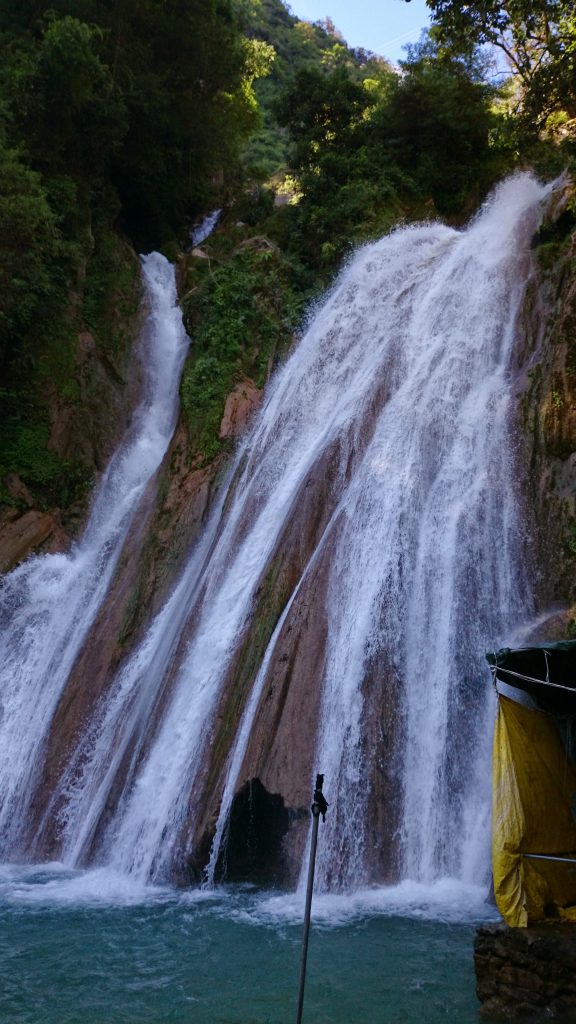
Kempty waterfall with the pool at its base.
Kempty waterfall is not inside Mussoorie town or even on the same mountain, but on the highway between Mussoorie and Uttarkashi. The waterfall is 13 km from town. But it is worth a visit because of the spectacular view. The fall drops in 2 cascades, forming a pool at the bottom. Around the pool are shops where you can rent bath wear / swim wear and changing rooms. You can take a dip inside the pool. A cable car or a fleet of stairs takes you from the highway to the pool at the base of the fall. At the highway there are some restaurants where you can tuck into Parathas or momos after your dip in the pool by which time you will feel really hungry.
Conclusion
Mussoorie is the type of hill station suited for walking over long distances and taking in the views of the high mountains of Garhwal and the greater Himalayas between Uttarakhand and Himachal Pradesh. While you can definitely enjoy the bustle of Mall Road, it is in the places that are a couple of kilometres away from the town that you begin to really enjoy this hill station. Mussoorie is well worth a visit and taking walks around this town is definitely recommended even though your legs will start complaining eventually.

